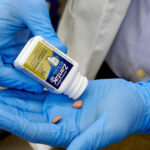The cleanup of a northwest Montana community where health professionals say hundreds of people have been killed by asbestos exposure entered a new phase Thursday as officials turn their focus to keeping residents safe over the long term.
The five-member Libby Asbestos Superfund Advisory Team met for the first time after being established by the Montana Legislature earlier this year.
The advisory team of state and local officials and one citizen selected by Montana Gov. Steve Bullock will work with environmental agencies to come up with ways to prevent further exposure to asbestos that remains beneath the soil and in the walls of many houses in the small towns of Libby and Troy.
The contaminated material can cause fatal lung diseases and other health issues. It came from a W.R. Grace and Co. vermiculite mine that operated for decades just outside Libby, a town of about 2,700 people near the Idaho border.
Since 1999, a cleanup by the U.S. Environmental Protection Agency has removed more than a million cubic yards of dirt and building materials from almost 2,500 properties in the area. That work – conducted under the agency’s Superfund program for the cleanup of highly contaminated sites – is expected to be largely finished by next summer, EPA spokeswoman Lisa McClain-Vanderpool said Thursday.
The price tag for the cleanup reached $575 million last year, she said.
As the EPA gets ready to take much of the area off the Superfund list, state and local agencies must come up with ways to handle future asbestos discoveries, such as when a house is renovated or an underground vermiculite deposit is found during excavation work.
Thursday’s discussion among advisory team members centered on the hiring of a “superfund liaison” to help steer the state’s efforts. Montana Department of Environmental Quality Director Tom Livers said the liaison would need communication and crisis management skills along with technical knowledge about the cleanup process.
“We’re looking for a skill set you don’t always find in one person,” he said.
Money potentially available for future operation and maintenance of the cleanup includes $11 million in EPA funds and $5.2 million in state funds that came from settlements in W.R. Grace’s bankruptcy case, said DEQ spokeswoman Karen Ogden.
There’s been no attempt to quantify how much asbestos will remain when the cleanup is finished.
Health workers have estimated that as many as 400 people have died and almost 3,000 have been sickened from exposure in Libby and the surrounding area.
The W.R. Grace mine was shuttered in 1990. The company agreed in a 2008 settlement to pay the EPA $250 million for cleanup work.
There is not yet a cleanup plan for the highly-contaminated mine site and surrounding portions of the Kootenai National Forest – a nearly 16-square mile (41-sq. kilometer) area that also includes some state and private land.
Was this article valuable?
Here are more articles you may enjoy.

 Beyond the Claim: How Social Canvassing is Transforming Insurance Fraud Detection
Beyond the Claim: How Social Canvassing is Transforming Insurance Fraud Detection  Harvard Study Again Stirs the Pot on Demotech Ratings of Florida Carriers
Harvard Study Again Stirs the Pot on Demotech Ratings of Florida Carriers  Sanofi to Pay $100 Million to Settle Zantac Cancer Lawsuits
Sanofi to Pay $100 Million to Settle Zantac Cancer Lawsuits  Report: Claims Handlers Embracing Technology
Report: Claims Handlers Embracing Technology 